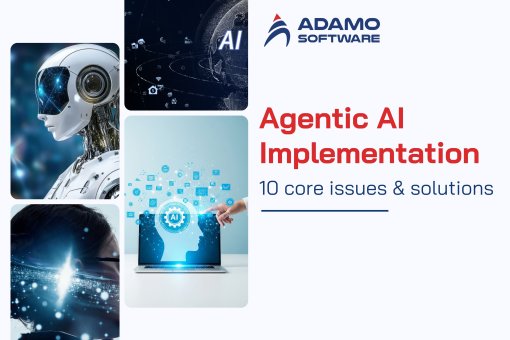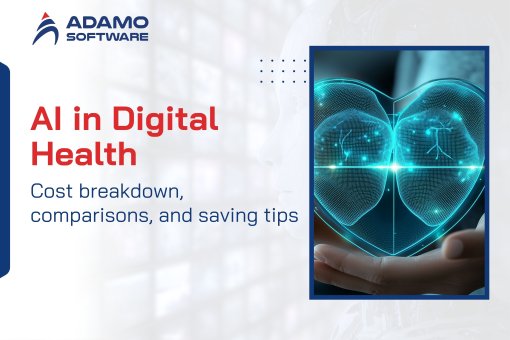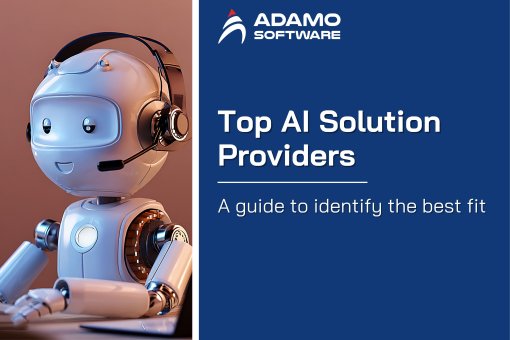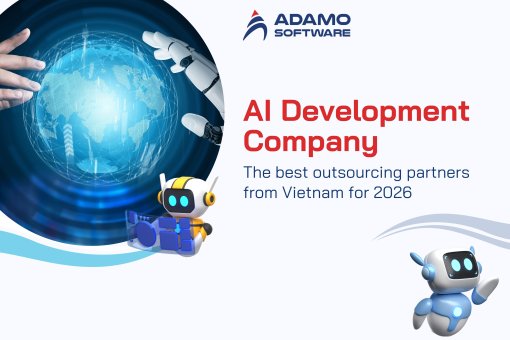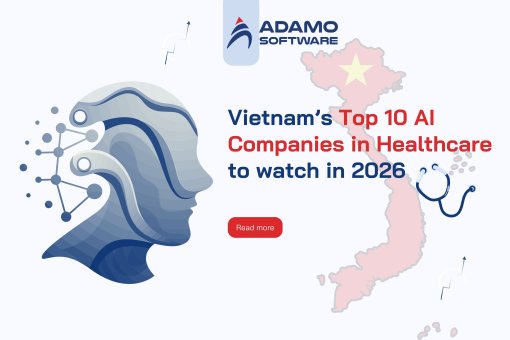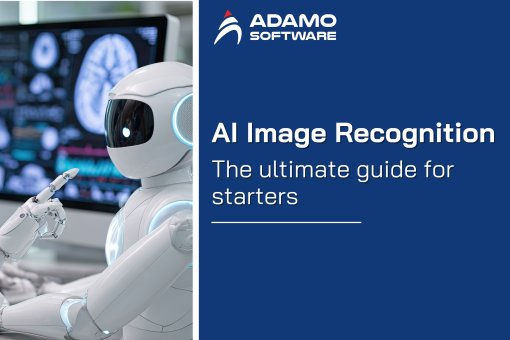
Explore the top AI trends 2026 transforming industries, from finance to healthcare, and learn how businesses can prepare for the next wave of innovation.
Artificial intelligence is entering a new phase, one of real-world impact rather than testing the waters. It is transforming the way people live, work, and connect. From AI-driven systems making autonomous decisions to data-driven decisions revolutionizing industries across the world, AI is changing at a rapid pace.
This blog will explore the most important AI trends 2026. It will also provide a useful roadmap for businesses to ready themselves, adjust, and succeed in the years to come.
I. Top 10 AI Trends 2026 to look forward to
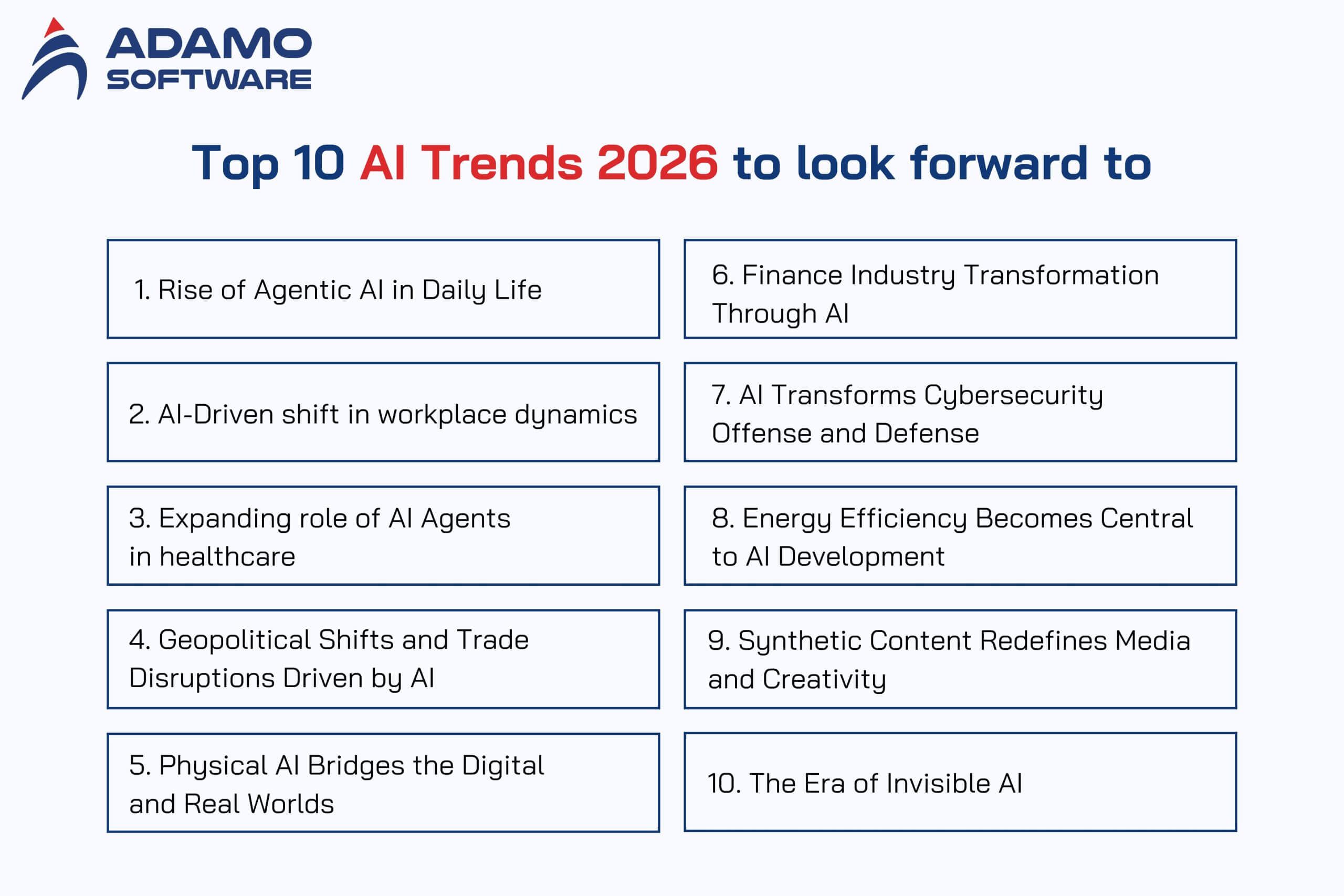
As we enter 2026, AI is no longer a technological revolution. It’s now becoming the basis for the way industries evolve and societies function. From workplaces to hospitals, from global trade to sustainability, the world is continually affected by the power of AI. Here are the top ten AI trends 2026 that will make an impact this year ahead:
- Rise of Agentic AI in Daily Life
- AI-Driven Shift in Workplace Dynamics
- Expanding Role of AI Agents in Healthcare
- Geopolitical Shifts and Trade Disruptions Driven by AI
- Physical AI Bridges the Digital and Real Worlds
- Finance Industry Transformation Through AI
- AI Transforms Cybersecurity Offense and Defense
- Energy Efficiency Becomes Central to AI Development
- Synthetic Content Redefines Media and Creativity
- The Era of Invisible AI
1. Rise of Agentic AI in Daily Life
Among the major AI trends 2026, agentic AI is one of the technologies that can change everyday interactions. In 2025, it was the hot topic of the industry, but the true effects of it will come in 2026.
Picture a smarter ChatGPT that cannot only create information but also handle day-to-day tasks. It can assist you in various activities such as booking trips, managing groceries, or operating smart home devices.
In the professional world, agentic AI will go beyond being an assistant. It will begin to coordinate systems projects, communicate with external partners, and drive long-term objectives across systems. Essentially, AI will become an autonomous teammate rather than a mere assistant.
2. The AI-Driven Shift in Workplace Dynamics
Within the scope of AI trends 2026, artificial intelligence is reshaping people’s work practices and collaboration. Workflow is enhanced by predictive analytics, automation, and intelligent tools that enable employees to focus on more valuable tasks.
AI-powered management systems are predicting bottlenecks, while the HR platforms are tracking engagement and performance. Virtual assistants also make scheduling and communication easy.
According to BCG’s “AI at Work” report, 72% of companies already utilize generative artificial intelligence tools, such as ChatGPT and Copilot, to enhance productivity. Yet adoption is only the beginning: 50% are re-engineering the workflow, and 22% are developing new business models. Leaders now spend up to 80% of their AI budgets on innovation and transformation, rather than implementation.
3. Expanding Role of AI Agents in Healthcare
Within the AI trends 2026, healthcare is one of the most promising areas regarding the adoption of agentic AI. Previous systems tended to deal with very specific functions such as symptom analysis or treatment recommendations. Next-generation AI agents, however, will deal with the entire patient journey. They will schedule diagnoses, review medical histories, plan treatments, schedule aftercare follow-ups, and follow-ups.
Patients will have a more comprehensive picture of their health thanks to these intelligent assistants, by linking lifestyle, medication, and risk factor measurements. On a macro level, AI in healthcare will prove even more useful due to the global shortage of healthcare professionals and rising costs.
4. Geopolitical Shifts and Trade Disruptions Driven by AI
One of the more complicated AI trends 2026 is that it’s having an increasing impact on international politics and commerce. Governments have come to see AI as a factor influencing economic influence, military power and technological leadership. The misuse of digital technology is already being used in propaganda to influence elections. Furthermore, restrictions on AI hardware trade are being used to damage rival economies.
Nuclear weapons aside, few technologies have threatened to upset the global balance of power like AI. As countries jockey for control, 2026 is likely to see an escalation of market, supply chain, and data flow manipulation. This case scenario is especially likely as world leaders look to gain their strategic upper hand in the AI race.
5. Physical AI Bridges the Digital and Real Worlds
One of the most outstanding trends in the field of AI trends 2026 is the rise of Physical AI. This is the convergence of AI and robotics, IoT technologies, and smart infrastructure. This integration enables machines to perceive and analyze the world around them and to interact in the physical world. It includes applications from warehouse robots and delivery drones to surgical assistants and traffic systems.
By integrating intelligence into physical systems, physical AI will make industries safer, more efficient, and more flexible. This will be beneficial across industries that were too complex or costly to automate previously.
Explore Our Tailor-made Software Development Solutions
We are confident in providing end-to-end software development services from fully-functioned prototype to design, MVP development and deployment.
6. Finance Industry Transformation Through AI
According to AI trends 2026, the finance industry is undergoing a significant shift, as automation and intelligent analytics are gaining prominence. McKinsey forecasts that AI could contribute $340 billion per annum in value to the global banking industry. Citi also predicts a 9% rise in profits over the next four years, with total profits approaching $2 trillion.
AI has now become an element of customer service, forecasting, and fraud detection. About half of CFOs say that they will launch AI-enabled customer experience tools in less than 18 months. Meanwhile, 24% use AI for fraud prevention already, and another 36% are set to become AI adopters.
According to NVIDIA, most financial institutions are working on data analytics to improve fraud detection and risk management. Technological platforms like Zest AI have also allowed banks to determine who will be a good borrower while minimizing biased outcomes.
Another example of a company using generative AI to analyze company filings up to 10 times faster than human analysts is Portrait Analytics. This enables investors to take advantage of opportunities earlier. The company recently secured $7 million in seed funding to expand its platform.
7. AI Transforms Cybersecurity Offense and Defense
One of the AI trends 2026 that is most important to consider is cybersecurity in terms of both risk and opportunity. Cyberattacks have increased by 21% in the year 2025 and the new technology, due to AI trends 2026, is increasingly providing new attack vectors.
Agentic AI is the perfect example of this. Tools such as ReaperAI can analyze networks autonomously, identify weaknesses, and run complex cyberattacks without any human interaction.
As Malwarebytes CEO Marcin Kleczynski points out, today’s threats are about more than volume. They now include completely new forms of deception and automation; forms that were unimagined even a few years ago.
AI-powered defense systems are, in turn, evolving too, and AI trends 2026 are emerging to counter them. Next-generation security agents will not only react, but will hunt, identify, and eliminate threats. In 2026, this change from reactive protection to adaptive, self-learning defense represents a new era in the battle against phishing, ransomware, and data theft.
8. Energy Efficiency Becomes Central to AI Development
Energy-efficient innovation is also among major AI trends 2026, as it is seen as a critical need. AI systems are consuming significant amounts of energy, and that has become critical. According to the U.S. Department of Energy, data centers alone could consume 12% of the nation’s electricity by 2028. This has brought home the need for cleaner and more sustainable sources of energy.
In 2026, energy efficiency will be a key aspect of AI’s future being discussed. This will include improving AI systems’ power and cooling, which are critical for millions of processors. At the same time, companies are looking at alternative energy solutions to fuel these increasing demands.
9. Synthetic Content Redefines Media and Creativity
Within AI trends 2026, synthetic conntent is transforming how media, marketing, and entertainment is produced and consumed. AI can now be used to create text, audio, video, and 3D assets, which reduce time to produce these assets, allowing for real-time personalization.
By 2026, technologies like text-to-video will become commonplace in the creative workflow, helping teams provide content faster and at a lower cost. In turn, audiences will be treated to hyper-personalized dynamic media.
This shift provides a clear competitive advantage to early adopters – increasing innovation, lowering costs, and expanding beyond traditional limits for personalization.
10. The Era of Invisible AI
Finally, the AI trends 2026 list concludes with the trend of Invisible AI. Just like the previous technological revolutions, AI will eventually be so ubiquitous that it will just be there, and people will no longer notice it.
So, for the younger generations, interacting naturally with machines or using AI-based systems will become a natural reality for them. By 2026, AI will no longer be treated as a unique innovation; it will simply be a new way of doing things in the world.
II. What businesses should do to prepare for AI Transformation in 2026?
Embracing cutting-edge tools is not the only step towards preparing for the next wave of AI trends 2026. It requires a clear vision, effective governance, and a strong human-technology connection.
Key steps that a business needs to take to prepare for large-scale transformation following the AI trends 2026 are as follows:
- Assess Data and Talent
- Build a Practical Roadmap
- Establish Robust Governance
- Reframe Product Design Around AI
- Plan for Scalable Infrastructure
- Design for Human–AI Collaboration
- Strengthen Data Protection and Compliance
- Measure ROI and Scale Strategically
- Partner for Specialized Expertise
1. Assess Data and Talent
Planning must begin with a good assessment of existing resources. The leaders should ask: What data do we have? What data do we need? And what kind of people can model and validate models? Improved data quality and availability eliminates errors and accelerates deployment.
2. Build a Practical Roadmap
A powerful roadmap to connect short-term automation wins to long-term innovation. Start by automating some routine tasks such as customer service or analytics through RPA and pretrained models. As the maturity increases, use generative AI for code support, content creation and design. Also, long-term investment in autonomous agents and domain specific models with good governance is crucial.
3. Establish Robust Governance
Governance needs to be an aspect of AI from the beginning. Log and version all datasets and models, perform regular bias audits, and ensure human approval of high-risk automation. Continuous performance monitoring ensures fairness, controls costs, and reliability.
4. Reframe Product Design Around AI
Redesign workflows to be commensurate with the capabilities of AI. AI can be used to control complex processes, and generative AI can accelerate the design, testing, and documentation phases. Multimodal search helps to boost product discovery and lower support load.
5. Plan for Scalable Infrastructure
Cost and performance need to be the drivers of architecture decisions. As an alternative, you can use AI-optimized chips to reduce the inference cost and edge AI for real-time applications such as IoT or AR.
6. Design for Human-AI Collaboration
True AI transformation is reliant on people. Train staff to take over outputs and make judgment calls where automation is limited. Assign clear roles, such as AI operator, reviewer, and escalation lead, which balance efficiency and accountability.
7. Strengthen Data Protection and Compliance
Ensure transparency and security. Effective data governance involves role-based access controls, minimising unnecessary data, and implementing explainability tools. These measures develop trust with customers, as well as with regulators.
8. Measure ROI and Scale Strategically
Track important metrics, such as time saved and reduced errors. New revenue from AI-guided products. Start with a few measurable KPI’s and increase as systems mature to have a clear view of performance.
9. Partner for Specialized Expertise
Companies do not have to deal with AI alone. Collaboration with experienced service providers accelerates the process and mitigates technical challenges. With the help of clear goals, powerful data, and good governance, businesses can make the popular AI trends 2026 work to their advantage.
III. Final thoughts

As you have seen, AI trends 2026 will not only affect business – they’ll rewrite the rules. Those who fall behind will be those who don’t plan ahead, responsibly build, and utilize disruption as a growth engine. To avoid this, it’s best to have a trusted partner who knows how to capitalize on these trends.
At Adamo Software, we have extensive experience in custom software, AI services, and end-to-end digital product delivery. We’re based in Vietnam and serve clients worldwide, designing and implementing enterprise systems, mobile apps, AI/ML models, and automation platforms.
We have already assisted organizations in using AI responsibly to speed up workflows, improve decision-making systems, and scale. With our agile teams, we can effectively bridge the gap between strategy and execution.
If you would like some help to take advantage of these AI trends 2026, Adamo is ready to assist you. Contact us now!






